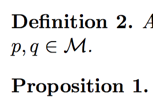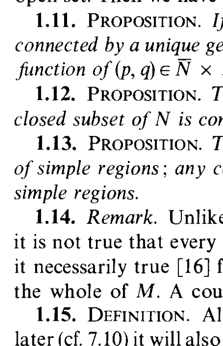02:49
52 mins ago, by
0celo7 Theorem: In Minkowski space, $p,q,$ are contained in a Cauchy surface $\Leftrightarrow$ $p,q$ have spacelike separation. Proof. No clue.
$\Rightarrow$ Trivial...?
@Slereah @ChrisWhite Is a Cauchy surface necessarily spacelike or can it have null parts?
What if we look at the causal diamond $J^+(p)\cap J^-(q)$
It must be compact if not empty.
We know that $p$ is contained in some Cauchy surface, call it $\Sigma_p$.
Then $J^+(\Sigma_p)\cap J^-(q)$ is compact.
Hmm, but that only works if $q\in D^+(\Sigma_p)$. Ok, assume that, we'll go for a contradiction.
We also know that $C(p,q)$ is compact.
Suppose that $\Sigma_p$ is properly embedded.
Hmm, let $[\Sigma_p]$ be the set of Cauchy surfaces containing $p$.
Ach, this is really hard.
Hmm, what if I do it in coordinates?
Set up global Minkowski coordinates with $p=0$.
Theorem: Then $p\vartriangle q$ iff $\exists v\in T_0M$, $\eta(v,v)>0$ s.t. $\exp_0 v=q$.
Maybe I like the notation $p\asymp q$ better.
So the geodesics in Minkowski are just $x^\mu(\lambda)=v^\mu\lambda +a^\mu$.
And we're picking $x^\mu(0)=0$, so $x^\mu(\lambda)=v^\mu\lambda$.
Any two curves (with the same endpoints) in Minkowski space are homotopic.
There is a smooth homotopy taking a smooth spacelike curve into the above geodesic.
Convex normal neighborhoods in Minkowski are big
So if $p\ll q$, then there exists a timelike $X\in T_pM$ s.t. $\exp_p X=q$.
If I can show that the above thingie, then I'm done because $\exp$ should be a global diff on Minkowski space
I need to find some way of determining $q$ in terms of $p$ and a spacelike curve...
Well, I know I'll have $q^i=p^i+x^i(1)$.
And $x^i(1)=\int_0^1\frac{\mathrm{d}x^i}{\mathrm{d}t}\,\mathrm{d}t$.
Yes, the proof is complete.




